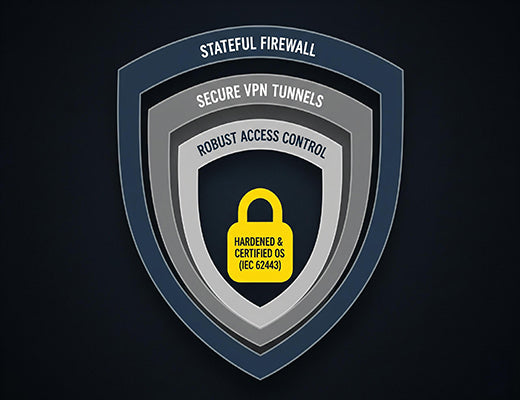
A Guide to Cybersecurity for Industrial Cellular Routers
|
|
Time to read 5 min
|
|
Time to read 5 min
Cybersecurity for industrial routers is no longer an optional extra; it's a fundamental requirement for protecting critical infrastructure. This guide provides a framework for evaluating the security of an industrial cellular router, moving beyond a simple feature checklist. We'll cover essential security layers like firewalls and VPNs, and explain why verifiable, process-driven security, validated by standards like IEC 62443 and third-party penetration testing, is the true hallmark of a secure device.
Connecting industrial assets to the internet introduces significant cybersecurity risks that must be actively managed.
A secure industrial router provides a multi-layered defense, including a stateful firewall, a comprehensive VPN suite, and robust access controls.
A vendor's security process is more important than their feature list. Look for verifiable proof of security, such as IEC 62443-4-1 certification for their development lifecycle.
Regular, secure firmware updates (OTA) are the lifeblood of long-term device security, making a powerful cloud management platform essential.
I was talking to a cybersecurity officer at a utility company recently, and he said something that stuck with me: "For years, our biggest threat was a squirrel chewing through a power line. Now, it's a teenager in a basement a thousand miles away."
He's absolutely right. As we connect our critical Operational Technology (OT) networks to the internet, we open a new digital frontier—one that is actively being targeted by attackers. An insecure industrial router isn't just a weak link; it's an open doorway into the heart of your operations.
Let's be clear: robust cybersecurity for industrial routers is not just about having a long list of features. It's about a fundamental commitment to a secure design philosophy. This guide will walk you through the essential layers of defense and, more importantly, how to verify that your chosen hardware partner takes security as seriously as you do.

One of the biggest security risks is unauthorized access. Your router must have features to control who can log in and what they can do:
The IEC 62443 standard is the most important benchmark for industrial cybersecurity. It's a series of documents that define best practices for everyone involved, from the asset owner to the component manufacturer.
Would you trust a bank that only audited itself? Of course not. The same applies to cybersecurity. Ask your vendor if their products and operating systems (like RobustOS) have undergone regular, independent penetration testing by a reputable cybersecurity firm. This provides objective, third-party validation that the device can withstand real-world attacks.

Cybersecurity is not a one-time setup; it's a continuous process. New threats emerge every day. The single most important activity for maintaining long-term security is applying regular firmware updates (patches) that fix newly discovered vulnerabilities.
This is where a centralized cloud management platform like RCMS is not just a convenience, it's a critical security tool.

When choosing an industrial cellular router, you are choosing a long-term partner for your security posture. Look beyond the feature checklist and evaluate their commitment to a secure process.
Ask the tough questions: Is your development process certified to IEC 62443-4-1? Do you undergo independent penetration testing? Do you have a robust platform for deploying security updates at scale? A vendor who can confidently answer "yes" to these questions is one you can trust to be the secure foundation for your critical network.
Learn More in our main guide:
A1: By far, the biggest mistake is failing to change the default administrator password. It's the first thing attackers check for, and it's an open invitation for a breach. The second biggest mistake is failing to apply security patches in a timely manner.
A2: A "hardened" operating system is one that has been specifically configured to be more secure. This involves removing all non-essential services and software, configuring security settings to be as strict as possible by default, and implementing special protections to reduce the system's "attack surface."
A3: The router's firewall acts as a gatekeeper. It can be configured so that only authorized traffic from a specific IP address (like your central control server) is allowed to reach the PLC's port. It will block all other unauthorized connection attempts from the public internet, effectively making the PLC invisible to potential attackers.